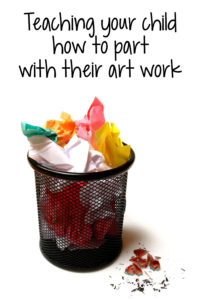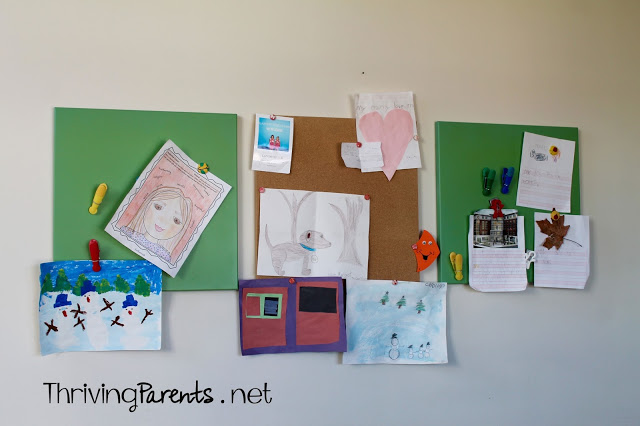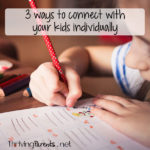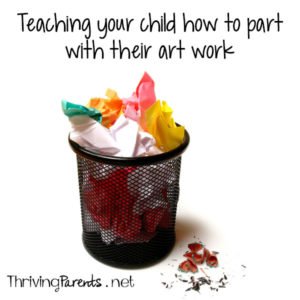
Are you having trouble getting your kids to part with their artwork? It’s a process that needs to be taught and I’ll be honest, it isn’t easy. Here’s how you can start.
When I wrote 4 ways to display your child’s artwork (which really turned into 5), the most popular question I received was “How do I get rid of all the other paper and projects without the kids getting upset or freaking out?”
I want to start this post out by saying it was about 4 years ago when my parents brought over a bunch of boxes from my childhood. It was full of report cards, trophies, awards, and class photos. It had my old ballet shoes, favorite books, and a million school projects that my mom had saved. I’ve fought my whole life with trying to part with things. I tend to want to keep everything and the result is I have an unfinished basement that is full of things that I don’t use regularly and haven’t looked twice at. I was working hard to purge our home and was so torn with the decision of what to do with these boxes. Even though my parents never said a thing about keeping the contents of the boxes, I felt a lot of pressure to do so because they had saved these items for over 30 years. It was painful. In the end, I tossed all of the projects and artwork. I liked looking at them and sharing them with our kids but they hindered in my ultimate goal to have an uncluttered house. I think most people feel like they’re happier and more organized when their houses aren’t cluttered. (I also got rid of the old report cards, after I realized I wasn’t as good of a student as I thought I was, and just about everything else.) Once it was gone, I felt great. The burden had been lifted. For that reason, I save very little for our own kids. I find that if I save it, even for a short time, I have a harder time parting with it.
Here’s what I save and how I save it:
I save their very first project.
I save the first time they write a sentence or story.
I save anything that shows they’ve overcome an obstacle or a hurdle for them. This can be a change in their handwriting (an old piece of work and a new one a year later) or a cutting with scissors activity. I save their report cards. I save anything that they’re extremely emotionally tied to. For our kids that’s this huge map that they made in their Montessori school. It took them weeks to make and is on a big sheet of posterboard. We’ll be framing them and hanging them up soon.
I save all the things I keep in a Rubbermaid tote. I like these because they stack on top of each other and they’re not huge. Plus, they keep water and other elements out. The older the kids get, the less work they bring home. They’re starting to work on more projects.
Some of you may legitimately want to keep everything – and that is totally fine! This post is meant to help people who do not.
Getting kids to part with their artwork is a common problem in parenting and it’s much harder to deal with than one would have ever thought. Have you ever been caught smuggling a pile of projects to the trash can? Has your child opened the trash to find their artwork in it? Ouch! The amount of tears that follow will rival the tears from any broken bone or dropped lollipop.
It can be so hard for them to part with their work, isn’t it? For them, it took a lot of work and concentration to create their masterpiece (or maybe it didn’t!) and they get so emotionally tied to them. In their minds, throwing out their work is almost like saying they (as your child) aren’t important to you. We know that’s not true but they lack the brain development to understand that. They need to feel love and belonging and keeping their artwork expresses that to them, even though it’s not always practical.
I want to say that teaching kids to part with their artwork is easier to do the earlier you start it. We didn’t start this with Katherine until she was in Kindergarten and it was hard, where Rebecca was always used to this method and never questioned it.
If you are starting this process late, like I would think most of you are, you can start by taking photographs of each piece of artwork, with your child holding it or without (but it is fun for them to see the photos of them holding their artwork). Tell them that you can print the photos out if they want you to, but the photos are available to look at online. Then whenever they ask to see them, bring up the photo. Don’t throw the projects out yet but always default to showing them the artwork online (via your phone, tablet, or a desktop computer) before showing them the actual project. If you do this for a while, they’ll eventually get used to seeing it online and may not even ask to see it. Eventually, you can start to smuggle some of the projects out of the house (via the trash).
If the project is no longer in your home and your child asks to see it, tell them you don’t have it any more but you took a photo of it so you could have it forever. This isn’t being dishonest. Even though we don’t take photos of projects any more, I still have all those early projects as photos online. Explain how projects take up space and they can start to rip and tear from the weight of the pile or the size of the space they’re saved in. In order to preserve it, you photographed it. If you’d like, you can take all the photos and put them into a Shutterfly photo book or print the photos out and put them in a mini photo album.
While you are doing this, you can explain to your kids how they can choose what to keep and display. Some weeks they may choose to keep nothing because they like the previous week’s work better. Letting them choose what they keep is the most important part of this process.
In the beginning I used to hang up what I liked the most. I didn’t even think about the fact that the kids may like something more until one day this conversation happened:
“Mommy, where’s my dog picture?”
“Oh, I don’t think we saved it. We didn’t have enough clips on the board to save that one too.”
“But that was my favorite one! I looked at a picture in a book to make sure I got the ears just right. It was what I worked hardest on.”
Insert crushing mama heart and a Daddy who went searching through the trash to pull it out.
(Side note, we have boards where each kid displays their work and it only has a certain number of clips on it. They can save as many pieces of artwork as there are clips. They also tend to share clips if they have a sibling who wants to save more things and they do not.)
Since then it’s been very important to use to ask the kids to choose what they want to save. This gives them the ability to feel in control of the situation and allows them to evaluate what’s most important to them that they would like to display.
What this looks like:
Our kids bring their work home every Friday so every Friday we all sit on the family room floor and they take turns showing us their work. This makes sure that we (the parents) see it all and they know we see it. This is important to them and helps to validate their importance.
“Let’s look at all this artwork you’ve brought home! Isn’t it a lot? I want you to know that we LOVE all this artwork but we just can’t keep it all. We really want to keep your most favorite pieces and display them in the house. Which 3 are your favorite this week? Let’s hang those up. We can take photos of the others.” This may require more talking through, especially if your child says they like them all. You can ask them questions to help them process this situation.
Questions like:
“Which are you most proud of?”
“Which one was the hardest?”
“Which one was the easiest to make?”
“Which one took the most time?”
“Which one did you already know how to do so you didn’t really need instructions?”
“Which one is your favorite?”
“Which one would you give away?”
“Which one would you like to keep?”
“Do you want to leave up any works from last week?”
Remember this is a process. It won’t happen over night and may take the course of a whole year for them to get used to the idea. Katherine’s in 3rd grade now and while she understands why we can’t keep it all, she still isn’t a fan that we throw some work out. She prefers she isn’t around when it happens. Caroline, however, throws her work out herself. Siblings can be so different sometimes.
Now, if you prefer, you can keep smuggling the artwork out of the house without them knowing. Do whatever feels comfortable and right to you. I wanted to be honest with our kids and although it took a while, we worked hard for them to be able to understand.
Do you have any additional questions that I may have missed? If so, ask away and I can add to this post.
xoxo
–k
If you are looking for ways to display your child’s artwork, check out the 5 ideas that are posted here.
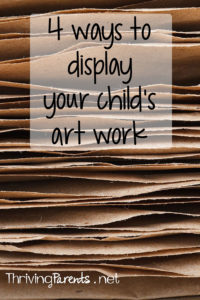
Is the thought of storing your kids’ artwork stressful? If you don’t know where to start, here are 4 great ways.
Kristina Grum is a Certified Parent Educator who has over a decade of experience working with children, including being a classroom teacher. She currently teaches parenting classes in her local area and writes about shifting parenthood from barely surviving to thriving.
